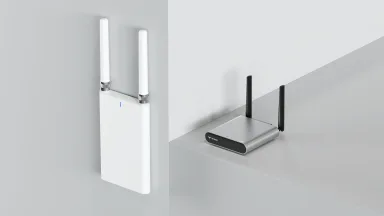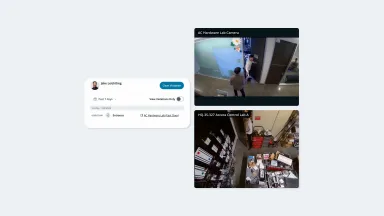Verkada Introduces Connectivity Solution for Hard-to-Wire Locations, Expands Features Across Command Platform
At Verkada, our product and engineering teams are continuously improving our products for our more than 20,000 customers. In our February 2024 Launch Event, we highlight the enhancements we’ve made across image quality, streaming, bandwidth management, and more. In addition, we announced improvements across our platform, including:
The GC31 Cellular Gateway, a new connectivity solution for hard-to-wire locations
Our new Command mobile apps for iOS and Android
The launch of Command on AWS GovCloud for video security and visitor management
New tools to manage access control at enterprise scale
To learn in-depth about these product milestones, continue reading below.
Connectivity
Over the years, we have seen many organizations struggle to connect and manage remote deployments. In particular, our customers often have a place where they would like to deploy a Verkada device — such as a parking lot, construction site, or remote area — but find it hard to do so due to a lack of internet connectivity. Trenching ethernet wire to these locations can be cost-prohibitive, while cellular deployments are complicated to piece together and difficult to manage.
GC31 Cellular Gateway
We set out to close this gap and make it easy for our customers to deploy a Verkada device anywhere, which is why we are excited to announce the GC31 Cellular Gateway. Simply feed the GC31 power, and it will connect and power up to two Verkada devices, making connectivity in hard-to-wire locations truly plug-and-play. We also offer an unlimited data plan for the GC31 that works worldwide with multi-carrier redundancy and Verkada’s 24/7 live support. In addition, the GC31 natively integrates with our products to enable faster setup, remote troubleshooting, and more efficient data usage.
Platform ease of use
We strive for our products to be easy to use, which is why ensuring an intuitive experience is at the heart of every new feature we design. At the same time, we are always using customer feedback to improve our existing features and workflows. Thanks to that feedback, we’re excited to share improvements to our mobile app, our login experience across both web and mobile, and our core alerts workflow.
New Mobile app
We’re excited to bring our new navigation and clean look-and-feel to our iOS and Android Command mobile apps. Users will notice a more consistent experience across the web and mobile versions of Command, as well as a completely redesigned mobile user interface — making it much easier for users to navigate Command on the go.
It is now simpler to move between products, add devices, and access popular features such as people and vehicle search on mobile. Our Alarms product is now fully integrated into the Command mobile apps, allowing users to arm/disarm and manage alarm sites from their mobile devices.
Face ID and Touch ID for faster login
Whether on your mobile device or the web, we believe logging into Command should be fast, simple, and secure. With this latest release, users are now able to authenticate and log into Command on the web or mobile interfaces using passkeys - a fingerprint, face scan, or security key - as they do with many other apps. Passkeys are not only more secure, but also more convenient, and can enable faster access to Command — especially in the event of an emergency.
New alert creation flow and device actions
Command helps make security teams more proactive through powerful alerting capabilities. With our Alert Inbox, admins and alert recipients can now create and manage all of their notifications in one place.
We have completely streamlined the creation process, enabling our customers to more easily set up alerts that help them respond to threats before they occur. In addition, admins can now trigger other devices in the Verkada ecosystem to respond to alerts. For example, users can set up a line-crossing alert that automatically triggers a pre-recorded talkdown message from a BZ11 horn speaker to deter trespassers.
Core functionality for investigations and response
When incidents occur, our customers need tools to be able to identify potential threats and respond in real time. Last quarter, we introduced Incident Management, a way to manage digital evidence after an incident has occurred to enable faster reporting and follow-up. This quarter, we have doubled down on our investments in real-time investigation and alerting functionality.
With this latest release, we are introducing two new alert types, additional functionality to assist in identifying People of Interest (POIs), as well as a new feature, Shortcuts, that allows a customer to follow a subject from one camera to the next in real time.
New alerts for loitering and line crossing
With line crossing alerts, it is now possible to trigger an alert if a person or vehicle crosses a digitally drawn line in a specific direction. This is useful in situations where you may want to monitor for trespassing, such as crossing a fence line. In addition, users can set new, time-based loitering alerts that trigger when an individual or vehicle remains in a specified location for too long.
Real-time POI detection and POI / LPOI linkage
Today, we already have powerful POI-alerting capabilities that enable users to be notified via email or text within seconds if a POI has stepped onto the premises. In many cases, however, users want to be notified of a POI on a live camera feed. With real-time POI detection, POIs are detected and highlighted within half a second when they appear on a camera in order to enable an even faster response.
We have also introduced the ability to link a Person of Interest (POI) to a License Plate of Interest (LPOI). Now, when you receive an LPOI alert, it will automatically surface the associated POI, making it easy to pull up any sightings of the individual on your premises.
Following subjects from camera to camera with Shortcuts
When it comes to live investigations, it can be challenging to follow a subject moving through a building. A user must know exactly which camera to shift to next to continue tracking the subject — but that may not be immediately clear based on the setup of the live feeds in Command.
To make this easier, we built Shortcuts. Now, with a single click, you can access nearby cameras using icons overlaid on the camera feed itself. Shortcuts are easy to set up and make it easy to navigate to the next camera over in order to continue tracking a person or vehicle in real time.
Government-Grade Solutions
We understand that many government agencies have specialized security requirements when it comes to their technology solutions, including adherence to the FIPS 140-2 standard and the stringent security controls for cloud hosting and data processing.
Today, we are excited to announce Verkada Command hosted in AWS GovCloud, which will initially support two product lines: video security (via four new models of FIPS-validated cameras) and Verkada Guest, our visitor management solution. This represents a significant milestone in our journey to build the strongest, most secure solutions for government customers. In the coming months, we plan to release additional FIPS-validated cameras across all of our camera lines and pursue additional certifications to meet the needs of government organizations.
Supporting enterprise-scale door security
Verkada Access Control products currently secure more than 6,000 organizations and power more than 2.5 million unlocks per day. Our customer base includes thousands of large public sector and commercial organizations, and we’re laser-focused on building door security solutions that can provide the visibility, scalability, and control they need.
Intercom management at scale
Larger organizations such as universities or hospitals often need to be able to route calls from dozens or even hundreds of intercoms to one location (such as a centralized security operations center). With our latest release, call receivers will now be able to view and receive concurrent intercom calls in Command. We’ve also made it easier to set up and configure large intercom deployments with shared call lists and bulk SIP registration, which allow users to manage call routing across devices and configure many intercoms simultaneously.
Door management at scale
This release also includes access control policy, management, and alert features for large and complex deployments. The new door access report gives admins quick insights about who can access which doors (and how). We're also excited to launch an anti-passback badge feature, which allows admins to prevent users from accessing configured areas twice in a row without first badging out at an exit door. Finally, we are introducing double badge, a feature allowing access users to toggle a door's schedule between unlocked to access controlled simply by tapping their credential to the reader twice.
What’s next
Over the coming months, we aim to expand functionality across all of these areas and continue investing in other parts of the platform. All of the software features outlined in this post will go live for existing customers on February 22nd, while the hardware ship dates vary by product. To learn more and view these features in action, be sure to read our in-depth blog posts and watch our February Launch Event.






